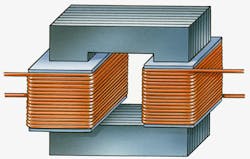If yours is the typical facility, most of your transformers are loaded at about 35%. A few of them are overloaded, and you can really feel the heat rolling out of the vent (if a dry type). Some sources suggest loading every transformer to some value, such as 85%, to achieve maximum efficiency. It’s not that simple, however.
First of all, the actual point at which loading achieves maximum efficiency varies by model and manufacturer. The manufacturer can give you the value for a specific model it makes. Due to manufacturing tolerances, this value isn’t exact but it’s close.
Don’t be a slave to matching your calculated load and the transformer spot on. You probably can’t do that anyhow, and energy efficiency is one of many considerations. It’s also worth noting that as you get closer to the optimum loading value, the increase of efficiency tends to diminish. So if the manufacturer says this model is at maximum efficiency when loaded to 88%, an application that loads it to only 75% is still far more efficient than one that loads it to only 35%. The key is to avoid grossly oversizing or under-loading the transformer.
Temperature rise is another factor in selecting a transformer for efficiency. The lower the temperature rise, the more efficient the transformer will be with a given load. Temperature rise is a function of how much heat is generated (e.g., less heat from a better transformer) and how much is dissipated out of the transformer case. You will pay more for a copper-wound transformer that produces lower temperature rise, but the energy savings will pay for that difference many times over through the life of the installation.
Specialized transformers present additional challenges. Some are, for example, optimized for lighting or for high-peak variable loads. Adding other types of loads reduces the efficiency that you were seeking. Plan carefully.
One way to defeat good transformer selection is to install the transformer such that it’s poorly ventilated (e.g., vent facing a wall) or next to a heat source (e.g., process equipment that emits heat). In commercial buildings, poor ventilation is institutionalized with a feature called the “equipment closet.” The real thought behind these is “out of sight, out of mind, and maximize the leasable square footage.”
These closets typically contain many NEC and OSHA violations, particularly those related to working space. And they routinely attempt to cheat the laws of physics, but never succeed. Not only do they present a hazard to maintenance personnel while lowering efficiency and reliability, they often create unwanted heat and noise for the tenants and usually present a fire hazard.
These closets exist not because the architect didn’t understand the space requirements, but because the architect didn’t understand enough to be able to persuade the builder or owner to pay for them. Good communication early in the design phase can solve this space problem. If you’re a contractor who bids on projects in commercial buildings, consider hosting free seminars for local architects and general contractors. You’ll help them avoid mistakes, plus you’ll be front of mind when they need to recommend a good electrical contractor for their next project.
About the Author

Mark Lamendola
Mark is an expert in maintenance management, having racked up an impressive track record during his time working in the field. He also has extensive knowledge of, and practical expertise with, the National Electrical Code (NEC). Through his consulting business, he provides articles and training materials on electrical topics, specializing in making difficult subjects easy to understand and focusing on the practical aspects of electrical work.
Prior to starting his own business, Mark served as the Technical Editor on EC&M for six years, worked three years in nuclear maintenance, six years as a contract project engineer/project manager, three years as a systems engineer, and three years in plant maintenance management.
Mark earned an AAS degree from Rock Valley College, a BSEET from Columbia Pacific University, and an MBA from Lake Erie College. He’s also completed several related certifications over the years and even was formerly licensed as a Master Electrician. He is a Senior Member of the IEEE and past Chairman of the Kansas City Chapters of both the IEEE and the IEEE Computer Society. Mark also served as the program director for, a board member of, and webmaster of, the Midwest Chapter of the 7x24 Exchange. He has also held memberships with the following organizations: NETA, NFPA, International Association of Webmasters, and Institute of Certified Professional Managers.

